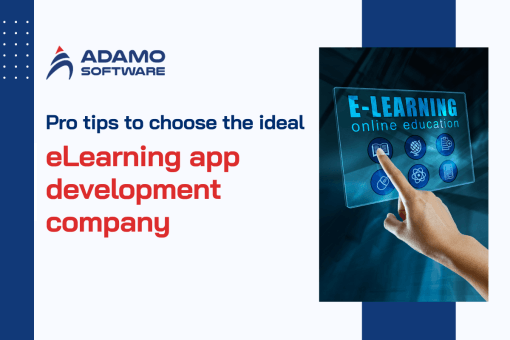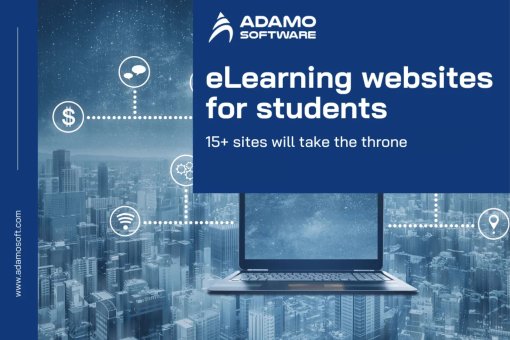Gamification Examples in Education: Best Ways to Use Game-based Learning
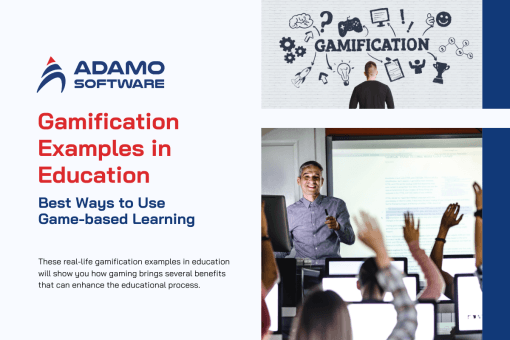
Formal education is also the application of a game concept in learning that sub-divides the traditional learning method into learning activities. Implementing points, badges, leadership, and incorporating narratives allows students to become active participants and perform better. Such game elements can be incorporated into learning. This will improve students’ interest, help them retain more knowledge, and create a joyful learning environment. This change to games has started to grow in usefulness across all educational levels and topics, which shows it to be a strong tool in the modern educational system.
This article reviews the general understanding of gamification examples in education, the benefits of adopting gamification in performance improvement, and strategies for making the whole concept work. In the next section, we will describe ten gamification examples in education to demonstrate how learning can be applied in various settings using games. The following gamification examples in education will explain how the shifts in the system can bring positive change in the implementation of the course modules. They will also inculcate an appreciation for learning in the students.
I. What is Gamification in Education
Gamification examples in education refer to integrating aspects found in games within learning processes to increase student interest. Consequently, points, badges, leaderboards, and levels incorporated in gamification turn mundane teaching processes into engaging activities.
It is important to note that people naturally compete and have an achievement orientation; for this reason, learning becomes more engaging. Some gamification examples in education are the point system used to motivate students. They encourage students to do more of their work, use digital badges to congratulate the learners and use dartboards to encourage competition among peers.
The overall purpose of gamification examples in education is not to arrange entertainment but to achieve more involvement and, therefore, better learning outcomes. Incorporating game design into education modifies the interaction between the individuals in the class and the subject. It enables the teachers to foster the active participation of students in class and motivate them to continue learning. Studies reveal that if the principles of gamification are executed properly, the levels of knowledge retention and engagement will be improved. And learners will also have a better attitude towards the learning process.
In general, gamification as a concept and tool used in education constitutes a strategic approach to the further development of this process. From the gamification examples in education, teachers can develop an interesting environment that addresses the needed enthusiasm and love for learning. Hence, students can work towards the accomplishment of their educational objectives more enviously.
Also read: Trends in Educational Technology to Watch Out 2024 and Beyond
II. Advantages of Gamification in Education
In general, the presence of game elements in learners’ activities has several positive aspects. These may contribute to the enhancement of the educational process. Here are some key advantages:

1. Increased Student Engagement
Introducing some collateral that supports and betters’ knowledge acquisition using the point system, badges, and leaderboards makes it even more enjoyable. This assists in maintaining focus and engaging the students fully. The application of gamification in education gives an insight into how the above aspects transform a monotonous lesson into the gamer’s landscape.
2. Improved Knowledge Retention
That is why the students interested in something also memorize the material taught. Some gamification examples in education are taking quizzes and feedback mechanisms. They will help the students be more obedient about or conform to what has been taught. Also, these gamification examples in education help them to be more knowledgeable in each field.
3. Encourages Healthy Competition and Collaboration
Learning games establish a competitive nature and foster collaboration among the learners. Competition on leaderboards and certain activities that are conducted in teams. This means that students must pull out the best in them while learning from others. Thus, they will realize both individual learning goals and group learning goals.
4. Instant Feedback
Students can learn from their mistakes at the appropriate time. Because the concepts that are frequently used in assessments take time to sink in. Gamification can respond instantly in the interim, allowing students to quickly correct any negative responses provided by the system. This is important for the learning process because mistakes need to be fixed right away.
5. Caters to Different Learning Styles
As we consider gamification examples in education, it’s been demonstrated that game elements are for different kinds of learners, including SEE, AUD, and KW. These variations should be applied to ensure that every student can grasp the notion in the course regarding their learning abilities.
6. Boosts Motivation and Persistence
Thus, by being part of the learning process in the form of games, the students maintain their interest during learning. The motivation arises from point gains, badge acquisitiveness, and occupying a better rank in a leaderboard. These factors encourage the students to work hard and solve all the challenges that are set for them to solve.
7. Enhances Problem-Solving Skills
Most of the gamification examples in education are actual life scenarios. They provide a certain form of challenge, thus the need for critical thinking. This way, students can sharpen their skills practically and experientially.
8. Promotes a Positive Learning Environment
Games make learning fun and earn the students’ goodwill instead of stress and anxiety. A correct tutoring environment contributes to the better mood of children when studying.
Thus, the effective use of gamification examples in education provides many benefits, including enhanced interest and knowledge, and constructive competition and teamwork. Through the applications of gamification examples in education, educators shall be able to offer an iconic and effective learning environment for the learners.
III. Best Strategies for eLearning Gamification Examples in Education
Gamification in the eLearning environment has shown that incorporation of the two features has significantly improved learners’ engagement as well as performance. Here are some of the best strategies to consider:
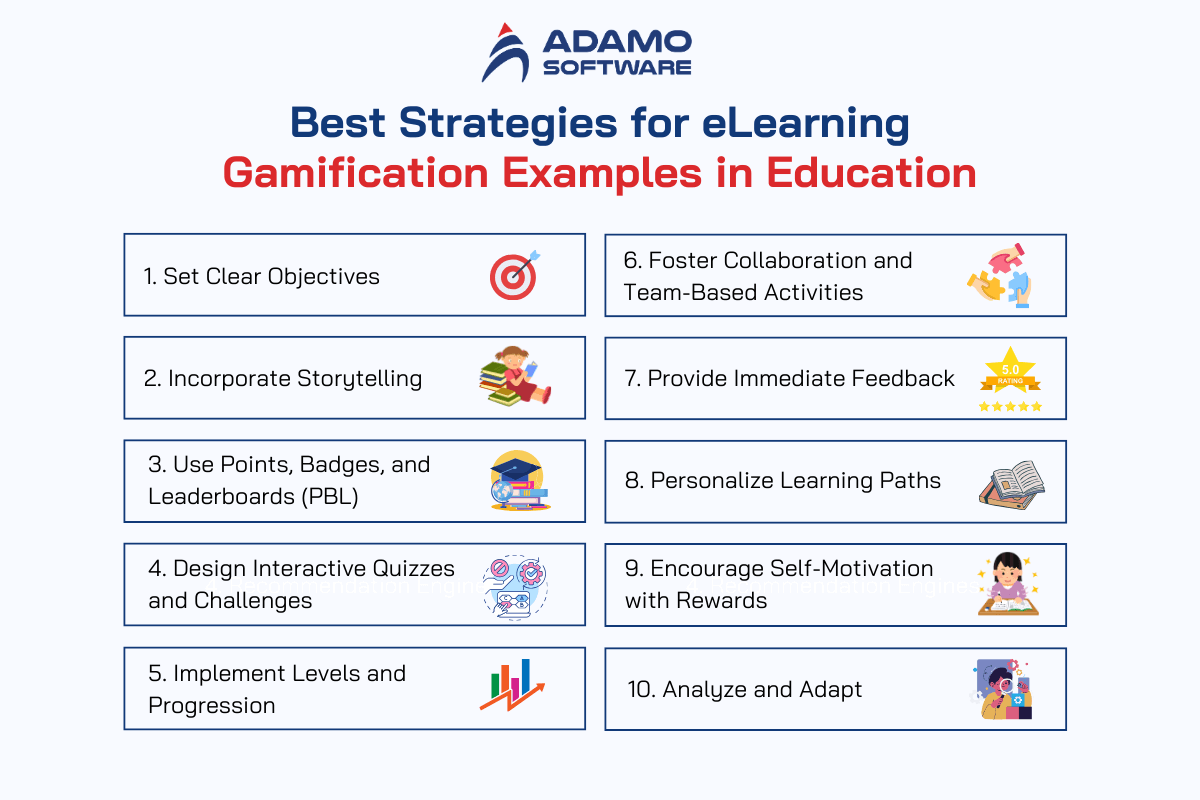
1. Set Clear Objectives
- Establish general learning outcomes and objectives that should correspond with the educational material that you possess.
- Make sure the objectives of the elements stated above are met; explain to learners why these activities must be done.
2. Incorporate Storytelling
- Engage the learners by adopting simple narrative styles when developing the training.
- Design reasonably realistic and understandable plots for stories that would contain educational materials so that ideas would be easier to memorize.
3. Use Points, Badges, and Leaderboards (PBL)
- The small points earned for homework, classwork, or quizzes can be used to encourage students.
- Stickers to represent new levels, expertise, or good behavior.
- Share daily rankings with the students so they can compete and see their performance outcomes. Control leaderboards to refresh them frequently to keep the interest of the people high.
4. Design Interactive Quizzes and Challenges
- Design a contest that informs students about correct and wrong answers within the shortest time possible.
- Encourage the use of annual objectives and schedules for critical thinking and problem-solving activities combined with workouts.
5. Implement Levels and Progression
- Organize activity-based stages that the learners can progress up to if they complete activities and instructions.
- In the progression from one level to the next, it should be designed to bring progressive improvement of learners and motivation between learners.
6. Foster Collaboration and Team-Based Activities
- Plan for tasks that the students must complete in teams and small groups.
- Promote collaboration among students to solve problems and share knowledge to attain group objectives.
7. Provide Immediate Feedback
- Provide instant feedback on the performance of the students to assist them in identifying their strongholds and weaknesses.
- Ensure that the mechanisms of parental feedback are positive and lead to improving the student’s performance.
8. Personalize Learning Paths
- Organize implementations with learners by considering abilities, interests, and other strengths or weaknesses.
- Admit the multiplicity of choices for students and actions within the framework of the gamified environment, stressing the principles of students’ independent choice and personalized approaches to their learning.
9. Encourage Self-Motivation with Rewards
- Both intrinsic and extrinsic motivation should be adopted in motivating the students. Intrinsic motivation can be the accomplishment of a task or learning of a new skill. While extrinsic motivation can be incentives such as points, badges, or certificates.
- Make a point of checking that whatever is used to reinforce learning is relevant to the goals and valuable to the learners.
10. Analyze and Adapt
- Finally, they should frequently check and evaluate data on students’ activity and achievement.
- Supplement this data by periodically updating and evolving the gamification strategies to match the existing trends.
By implementing these best strategies for eLearning gamification, educators can create dynamic and engaging learning experiences. Utilizing gamification examples in education can provide valuable insights and inspiration for developing your gamified learning environment. These strategies not only enhance student motivation and engagement but also lead to improved learning outcomes and a more enjoyable educational experience.
IV. 10 Gamification Examples in Education
Introducing game elements into education has been named as one of the most effective practices. It contributes to the increase of students’ interest and the improvement of performance. Below are ten gamification examples in education that show the efficiency of ludic learning methods in different learning scenarios.
1. Classcraft
The use of this platform in teaching makes the classroom transform into an adventure game. In this adventure, students must take on certain roles, such as mages, warriors, and healers. This point system applies to behaviors, achievements, and any demerit that is recorded and is equivalent to several points.
Classcraft as one of the gamification examples in education makes students work in teams. It also encourages them to be as active in class as possible, thus improving the classroom environment. The fact that it involves the creation of roles that the students must play helps create social relations and common goals to be achieved.
2. Duolingo
Engaging and stimulating learning, Duolingo currently enables students to work through lessons to gain points and level up, in addition to receiving specific rewards for learning.
Thus, Duolingo’s strategy has learners glued to the app and ready to practice extensively, which goes a long way in enhancing the learner’s retention of the languages. Another striking feature of the app is streaks and rewards, which are very effective in maintaining consistent practice and play an eminent role in language learning.
3. Kahoot!
Kahoot! allows the concerned teacher to come up with games like quizzes that the students can solve. The players receive points if the answers are correct, and the quicker, the better.
The competitive mindset and the instant response increase the student’s interest and make the process fun. Kahoot! involves an entertaining activity and challenging standardized tests and, thus, contributes to students’ positive approach toward learning.
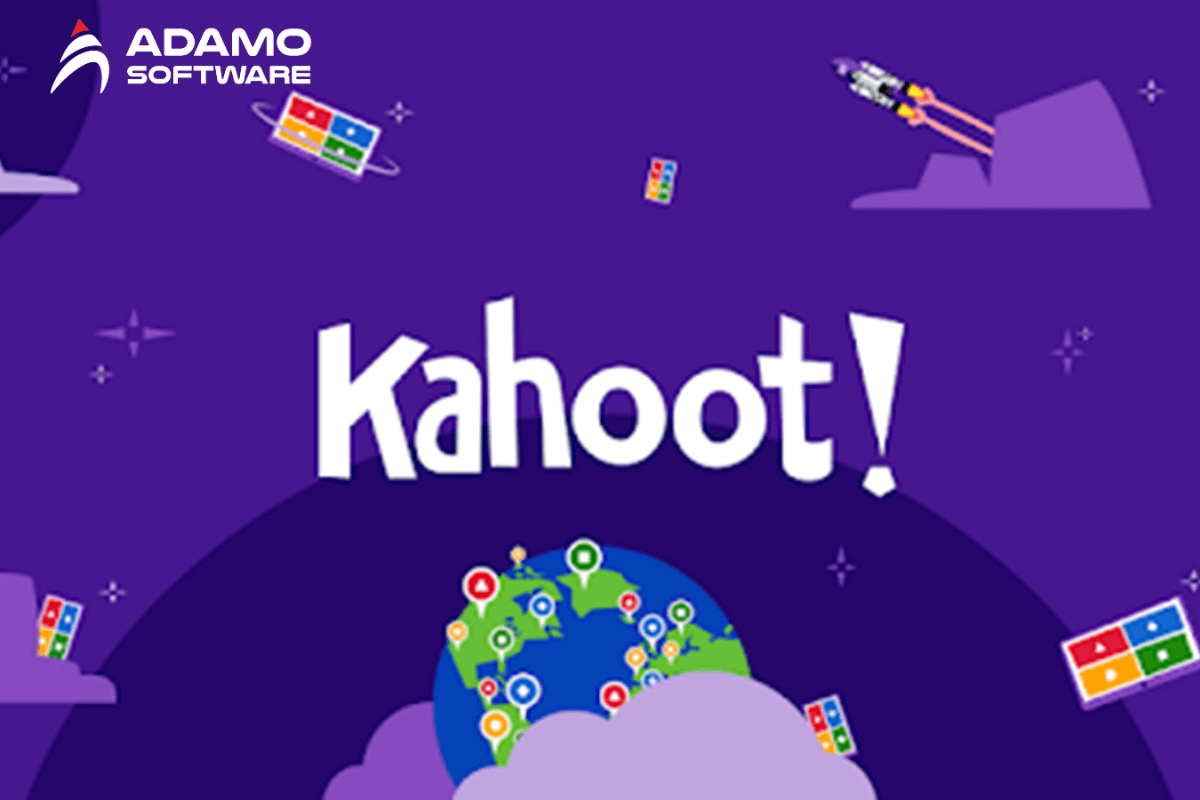
4. Minecraft – Education Edition
This is a variation of Minecraft that is meant to be used in schools where children can learn concepts in math, history, and computer science in interactive form.
Because the game can be played interactively, children can enhance their creativity and problem-solving abilities. Students can use visuals to better conceptualize the types of concepts being taught. They are also able to play in a simulated area, which helps with knowledge retention.
5. Quizizz
Quizizz is an interactive quiz tool designed to pose questions and time them as students answer numerous questions to get points or defeat their counterparts.
Thus, the class format and the ability to receive immediate feedback make for better knowledge retention and students’ interest. This is particularly advantageous in Quizizz because it paves the way for the students to learn at their level and speed. At the same time, attending to all the participants ensures that no students will be left out of the learning process.
6. Prodigy Math Game
A Math game known as Prodigy Math Game transforms math practice into a game like the famous games such as Super Mario where students fight avatars and do math questions to defeat them.
It will be especially useful to supplement the homework as it turns their math problems into a game, and replaying it helps children do better. Probably, the storyline and character progression encourage students to solve more problems and provide them with several practice exercises in a creative setting.
7. Habitica
Habitica is another one of the best gamification examples in education that brings your daily activities and to-do list into play and game. Students gain points based on the assignments they complete and the good habits they develop.
This application assists learners in managing their time and other related time practices. In turning every task which has to be done into a game, Habitica helps students to remain productive and enthusiastic.
8. ClassDojo
Among the gamification examples in education, ClassDojo fosters fun in managing classes. The app allows teachers ro reward or punish students by deducting or adding points based on their performance in tests and assignments. It is also flexible in that teachers can choose the rewards and feedback type.
It enhances a positive classroom climate and helps them foster the culture of working hard to achieve the best results. By providing feedback buttons easily accessible by teachers and students, ClassDojo enables students to be aware of the consequences of their behavior, hence transforming it.
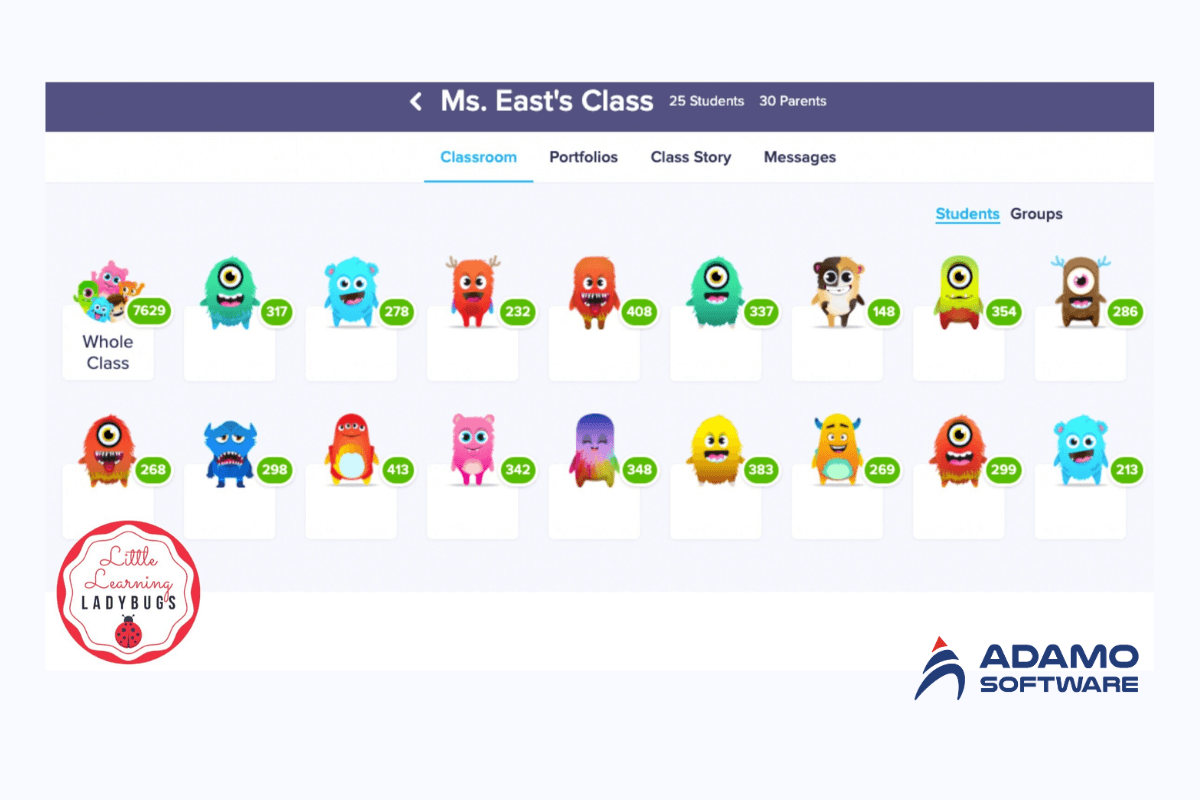
9. Breakout EDU
Breakout EDU has games which are escape rooms that aim to teach students critical thinking and collaboration. Pupils must complete some tasks about the curriculum to open digital locks.
These interactional assignments empower students to focus and work in groups to achieve the lesson’s objectives. The fact that the ends of the tasks are time-bound is effective for developing their critical and problem-solving skills and collaborative behavior.
10. Seesaw
Seesaw, the last one of the top ten gamification examples in education, enables students to share their learning products and get teachers and fellow students’ stamps and comments.
The platform helps to focus on researching the personal path to enhance productivity and embodies learning as a more personal process. The Learning Management System used in the class is Seesaw EDU. The portfolios enable students to have prints of the progress they have made. This helps to increase their confidence and makes them embrace the growth mindset.
V. Why Choose Adamo as Trusted Education Software Development Companies?
The strategy of applying game concepts to the teaching and learning processes is useful in enhancing performance among students and making learning more engaging. The ten gamification examples in education discussed show how a variety of game elements can be used to make teaching truly engaging, motivating, and fun. When these gamification examples in education are used, the professors can make classes lively and filled to create an environment that is friendly toward learning.

Thus, given the budding development of educational technologies, the gamification processes’ potential for further innovations will only increase. This affords even more prospects for enhancing education.
This might help you have a better picture of gamification examples in education. If you want to create your own mobile apps or web app-based for educational purposes, Adamo is here to help. We excel at building mobile apps and websites for educational institutions or schools, contact us for more advice.






